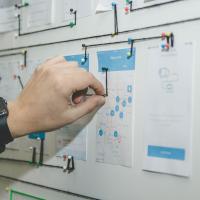A Framework for Scaling Continuous Testing across an Enterprise

Under pressure to keep up with the new digital economy, enterprises around the world are constantly rethinking their approaches to doing business. They seek to innovate as quickly as possible by delivering software rapidly and have adopted agile and DevOps methodologies to accomplish their goals.
This adoption process normally starts with smaller, innovative development teams that experiment with new tools and processes. After achieving some successes and realizing the desired benefits, the company wants to scale it across all the other teams.
At this point, the company finds out that scaling agile and DevOps across a large enterprise is much more difficult than practicing it in smaller groups. They usually turn to well-defined frameworks like SAFe (Scaled Agile Framework), LeSS, or even the Spotify scaling model to help guide them.
Throughout this journey, focus tends to be placed on development, as can be seen in all the documentation around agile development and agile frameworks. Although these frameworks mention that continuous testing should be implemented and quality should be inherent in the process, they fall short in providing the details on how to accomplish those tasks.
As a result, testing teams struggle to figure out the best practice to support the faster development cycle. They end up sacrificing quality and become the bottleneck in the software delivery pipeline.
The ACT Framework solves this problem. Its purpose is to fill in the gaps found in the agile frameworks around testing and to guide testing organizations on how to implement and scale continuous testing to support the company’s digital transformation, without sacrificing quality for speed.
The ACT Framework describes how the journey for scaling agile and DevOps starts with the foundation of an organization, which includes the vision for the transformation, core values around testing, and the roadmap required to successfully traverse the route.
In the center of the framework is the feedback loop. The feedback loop defines the testing processes to ensure the desired test coverage and to provide transparent and rapid feedback to the appropriate stakeholders throughout the development lifecycle.
Around the feedback loop, the framework defines the roles, activities, processes, and implementations practices required across three distinct levels in the organization: team, program, and enterprise. It also defines several shared teams to help support and coordinate the work between the levels. Finally, it defines a set of implementation tools, including ROI calculations, assessments, and workshops, that help with the implementation of the framework.
The goal of the ACT Framework is to provide a detailed guide that can be used by everyone involved in quality at a company. It contains detailed information on how to implement an effective test automation solution, which can be leveraged by testing practitioners to improve testing efficiencies. It also details how to create an organizational structure to support effective and efficient testing across a large enterprise, which can be leveraged by the head of QA or even CIOs.
In order for organizations to realize the benefits of DevOps, continuous testing is essential. Having a testing-focused framework will give quality professionals guidance on how to scale continuous testing practices across the entire enterprise.

